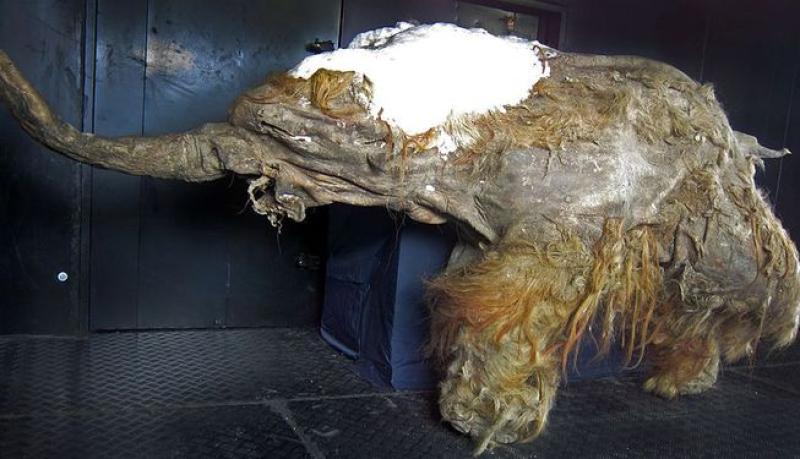Cells from a 28,000-year-old woolly mammoth have been 'revived'


Cells from a 28,000-year-old woolly mammoth have been 'revived'
By Bryan Nelson, Mother Nature Network, March 13 2019

The revived cells were retrieved from this mammoth carcass, named 'Yuka.' (Photo: Cyclonaut /Wikimedia Commons)
We may have just gotten one step closer to reviving one of the most iconic megafauna of the Pleistocene Epoch. Researchers at Kindai University in Japan recently extracted nuclei from a preserved woolly mammoth carcass, implanted them into the egg cells of mice, and watched as the bits from the extinct beast became reanimated, reports Phy.org .
It's a stunning breakthrough that demonstrates the resiliency of life, and could eventually bring the long-extinct species back from the dead.
"This suggests that, despite the years that have passed, cell activity can still happen and parts of it can be recreated," said genetic engineer Kei Miyamoto.
The mammoth cell nuclei were taken from the icy remains of a 28,000-year-old carcass recovered from Siberian permafrost back in 2010. That specimen, which has affectionately been named "Yuka," has been considered a prime candidate for DNA extraction due to the fact that it is so extraordinarily well-preserved. No one expected that life-like activity might still be observable in its cells, however.
For the experiment, researchers extracted bone marrow and muscle tissue from Yuka's remains, and inserted the least-damaged nucleus-like structures they could recover into living mouse oocytes, or egg cells. Incredibly, a number of these mammoth-modified cells sprang to life with cellular activity shortly after being inserted into the oocytes.
"In the reconstructed oocytes, the mammoth nuclei showed the spindle assembly, histone incorporation, and partial nuclear formation," explained the authors in their paper .
Although the cells did show impressive activity, they did not manage to divide. That's not a big surprise, however. What's incredible is that the mammoth nuclei still had life in them at all. They've been on ice for 28,000 years.
Cell division, and ultimately the resurrection of woolly mammoths, is nevertheless the topic now on the top of researchers' minds.
"Once we obtain cell nuclei that are kept in better condition, we can expect to advance the research to the stage of cell division," suggested Miyamoto to The Asahi Shimbun .
If scientists get these cells to divide, it could mean that Yuka could be cloned. The dream would be to eventually design a Jurassic Park-style attraction for resurrected extinct megafauna. Call it "Pleistocene Park."
While there are still significant hurdles to overcome before we can talk about building a zoological park for once-extinct creatures, this research certainly makes the dream more lucid. The next breakthrough will probably need to be technological in nature, as we perfect our tools for extracting and reanimating these nuclei.
This discovery wouldn't have been possible with the technology available back in 2010, when Yuka was first found. It stands to reason that new breakthroughs will be made possible given another few years for the technology to develop even further.






Jurassic Park here we come. If I recall, there were stories at one time about people having their bodies frozen so that when the technology became known, they could be revived one day in the future. What about Einstein's brain?
The thing is, the people's personalities and memories would still be gone even if their bodies could be revived.
I think there is something about Einstein's brain, tho. His brain was wired differently than average people
He had an extraordinarily high level of blood flow.
Once you're dead, it's too late. Now, if someone chose to get frozen while they're still alive, and could be kept alive and then brought back to consciousness ... that could be interesting.
Frozen while still alive = still dead
I think. I could be wrong
Currently for humans, that is true. But in the future ... who knows?
If you are talking about suspended animation, then you would be the same person. The only problem is, there would be a reason that you were suspended in the first place, like old age or disease.
Without a way of either curing the disease or reversing age ( yes you might be able to attach the head to a younger body but the brain would still be old), there is no point.
Wasn't this part of the plot line for Jurassic Park?
I don't recall if the prehistoric beings were grown from DNA or cells or whatever in the movie.
DNA taken from preserved mosquitos in amber, the problem with that is the mosquitos inject an enzyme that breaks down the blood cells so the likelihood of obtaining a complete DNA strand is not likely.
Thanks, It was at the very beginning of the movie. I kind of liked the idea - it kind of gave the movie a premise!
Interesting......
While I understand the scientific fascination with wanting to bring these creatures back, I cannot help but wonder what ecological niche they could fill. I mean let's face it, their time came and went just like the dinosaur's did. Just food for thought.
Where would woolly mammoths live? They lived during the time of the ice ages. We're running out of ice for them
My point above exactly.
Running out of ice? Don't tell that to anyone that lives around the Great Lakes; or in Canada right now.
Now, would anyone want something larger and more powerful than an African elephant, and possibly far more aggressive in their back yard?
Fascinating. I hope they succeed. The implications would be amazing.
There may be a misconseption about the time frame of the Wooly Mammoths place in the history of the world.
The last Wooly Mammoths died off only 5,600 years ago. A recent discovery is quite fascinating.
This is amazing.
Imagine what we could learn if we actually succeed in bringing back long extinct species of life.
The key problem with that, however, is that the environment in which they lived no longer exists. There is a lesson to be learned from the Jurassic Park story. Once life exists, it tends to tenaciously hold on.
What about the passenger pigeon or the dodo bird?
Ever watch "The Zoo" on the animal channel?
They have the last pink headed passenger pigeons and can't get the male to fertilize any eggs...
Is he impotent or just lazy?
Seems harmless enough but do we really have a way to determine the consequences of our actions? Not a problem if the population is contained. But if not, what harm might we cause?
'Lazy' is unlikely when it comes to the male sex drive.
Probably waiting for someone to massage his feathers. Are there massage parlors that do that..
Wait, what...LOL
What - send him to Florida????
Maybe he's gay.
Have they tried Viagra?
I think that this is very cool. I hope they succeed. I don't think we should be reanimating every animal that ever lived since we all saw Jurassic Park, but this is an animal that is akin to one that already exists and as mentioned earlier, we could bring back animals that are either recently extinct or those close to extinction.
I think the large animals from Jurassic Park would be fine, they may be dangerous but they're so large they can't hide so they're easy to kill if they escaped. In reality they wouldn't be as hard to kill as the movies make it seem it would be just like killing an Elephant you just need a high powered rifle, the bigger the better. The little turkey sized ones that hunted in packs would be a mistake, if they escaped they could hide and become an invasive species. Who wants to be surrounded by thirty of those things while hiking. Forget about those Velociraptors too, they're small enough to fit through doors and hallways so they'd be to hard to hide from. No Dinosaurs smaller than a pickup truck would be a good guideline.
Those velociraptors could OPEN doors....
So can most parrots...
and we had a large cat once who knew how to use a door knob but it only worked for him on one side of the door frame
when he could use his weight to push the door open.
He couldn't figure out that his own weight kept him from pulling a door open.
How about only herbivores - no carnivores.
Those animals are starting to get smarter than some people these days.
Well in a Jurassic Zoo I'd think a T-Rex would be worth having because it would sell tickets but if you have a T-Rex there's no need for smaller versions or similar variations. It would be awesome to see a savanna exhibit like Jurassic Park with all herbivores running wild in a natural setting.
I have two large black cats that are brothers that do the same thing. If my bedroom door is not quite shut all the way, they will use their claws at the base of the door and pull it open just far enough to use their weight to open it the rest of the way to truth on or out.
T-Rex is probably the scariest prehistoric creature, and next to them I would think Pterodactyls would qualify, but, as was said in Jaws: "You need a bigger boat", in such a "zoo" you'd need a really big bird cage.
Ha, open doors, let's see them try this Doc.
Dachshund Boogie
I can open doors. I just can't open videos. LOL
LOL, good one Buzz.
T-Rex, although scary looking, was more than likely a scavenger, it couldn't run very fast, had short forearms that couldn't grasp prey very well, but had a great sense of smell that could smell a carcass miles away.
Yea. Work on the white rhino. Only two left I read.